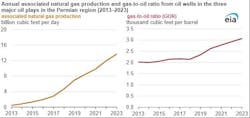Associated natural gas production in three Permian oil plays tripled since 2018
Production of associated-dissolved natural gas, or associated natural gas (natural gas produced from predominantly oil wells), has nearly tripled since 2018 in the three top-producing tight oil plays in the Permian region. Associated natural gas from Wolfcamp, Spraberry, and Bone Spring plays averaged a combined 13.7 bcfd in the first 7 months of 2023, up from an average of 4.7 bcfd in 2018, according to data from Enverus DrillingInfo.
Associated natural gas production has grown due to increases in both crude oil production and the volume of natural gas per barrel of oil that a well produces, namely the gas-to-oil ratio (GOR), among the oil wells in these three plays.
Any increase in an oil well's GOR means more natural gas is being produced per barrel of oil. According to the US Energy Information Administration (EIA), wells with a GOR of less than or equal to 6 Mcf/b are defined as oil wells. Wells with a GOR of more than 6 Mcf/b are defined as natural gas wells.
As more oil and natural gas are released within a well, the GOR tends to progressively increase, increasing the volume of associated natural gas produced per every barrel of oil. Pressure within the reservoir declines progressively as more oil is brought to the surface, which allows more natural gas to be released from the geologic formation.
The Permian region, situated across parts of western Texas and southeastern New Mexico, stands as the foremost producer of crude oil within the US, accounting for over 40% of total US crude oil output. Additionally, it ranks as the second-largest natural gas-producing region in the country, contributing about a quarter of total US marketed natural gas production. Most of the natural gas produced in the Permian region is associated natural gas. Consequently, the increased crude oil production in the Permian region has led to a simultaneous rise in associated natural gas production.
According to EIA’s Drilling Productivity Report, the average crude oil production in the first 9 months of 2023 experienced a notable 68% surge in the Permian region compared to the levels recorded in 2018. During the same period, natural gas production in the Permian exhibited an even more impressive growth rate, soaring by 104%.
Spraberry, Wolfcamp, and Bone Spring plays produce most of the associated natural gas within the Permian region. In 2023, these three plays produced 13.2 bcfd more associated natural gas than in 2013. Higher crude oil production accounted for 65% of the increase in natural gas production, and 35% of the increase came from a higher GOR, which rose to 3.1 Mcf/b in the first 7 months of 2023 from 2 Mcf/b in 2013, according to Enverus DrillingInfo and EIA.
